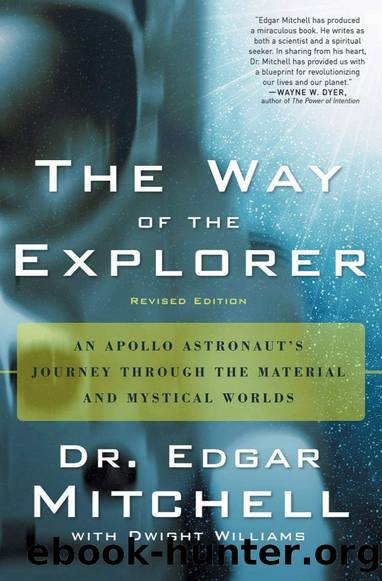The Way of the Explorer by Edgar D. Mitchell

Author:Edgar D. Mitchell [Mitchell, Edgar D.]
Language: eng
Format: epub
ISBN: 9780399141614
Amazon: 1564149773
Goodreads: 548635
Published: 2009-09-03T20:28:18+00:00
The Way of the Explorer
148
details of air mass movements are so complex that practical solutions are only knowable as probabilities. Thatâs why the weatherman speaks only of a 10 or 20 percent chance of rain, or that it will be partly cloudy. Far-from-equilibrium processes contain so much energy moving so rapidly that the slightest perturbations anywhere in the system, even from a seemingly insignificant source, can cause large unpredictable consequences such as the âbutterfly effect,â in which it is suggested that a butterfly flapping its wings over Beijing might cause a snowstorm in New York.
Being far-from-equilibrium causes the character of the process to change unpredictably. Such transitions from predictable to unpredictable movement are called bifurcation points. The process at the bifurcation point branches such that it suddenly creates a whirlpool or a tornado in an air mass, for example. The fact that the macroscale universe consists largely of these entropic, nonlinear, irreversible processes, and not the deterministic, simple, time-reversible processes of classical science, helps us realize that the arrow of time only flows in one direction here in the macro-world. In other words, natureâs energy only moves forward through irreversible processes. The process cannot run backwards. Nature knows nothing of time; all she follows is process as energy and matter flows in its cosmic dance. Time is an invention of mindâa part of the map, not the territory.
The consequence of this is that information, defined as a pattern of energy, cannot come from the future and be known in the present, even through nonlocal means. The future can only be predicted as a probability, because it consists of quantum entities at the microscale, and irreversible processes at the macroscale. Neither requires nature to have a notion of time; only our attempt to measure requires this. If we think of ourselves as floating in a tiny canoe through a turbulent stretch of rapids, just going with the flow, then we have a good idea as to the physics of life. We cannot predict our path from minute to minute within the river. Even though we understand the overall process of streamflow and know weâll eventually get to the ocean, we simply canât predict our exact course. With the intention of finding smooth water and a paddle in our hands, we can influence the process, but only to a certain degree. Life itself is a dissipative process.
And telling you this story, being an irreversible process, has just reached a bifurcation point. I want to discuss more about time, but also tell you about chaos. Yet I cannot discuss both subjects simultaneously, because language, too, is a linear, sequential process, which I am using to describe nonlinear processes. Therefore, I must choose.
In nature, time has only one direction. We call this the arrow of time.
The origin of the arrow is still a bit elusive, but it most likely originated
Invisible Realities
149
after the big bang, if indeed there was one, as the expanding universe began to cool.1 The arrow of time is completely defined by
Download
This site does not store any files on its server. We only index and link to content provided by other sites. Please contact the content providers to delete copyright contents if any and email us, we'll remove relevant links or contents immediately.
Endurance: Shackleton's Incredible Voyage by Alfred Lansing(4635)
The Motorcycle Diaries by Ernesto Che Guevara(3940)
Alive: The Story of the Andes Survivors by Piers Paul Read(3929)
Tokyo Vice: An American Reporter on the Police Beat in Japan by Jake Adelstein(3909)
Exit West by Mohsin Hamid(3748)
Apollo 8 by Jeffrey Kluger(3607)
Aleister Crowley: The Biography by Tobias Churton(3540)
Annapurna by Maurice Herzog(3403)
Full Circle by Michael Palin(3355)
Into Thin Air by Jon Krakauer(3268)
Kitchen confidential by Anthony Bourdain(2974)
In Patagonia by Bruce Chatwin(2837)
A Wilder Time by William E. Glassley(2795)
Finding Gobi by Dion Leonard(2726)
The Ogre by Doug Scott(2606)
Into the Wild by Jon Krakauer(2553)
L'Appart by David Lebovitz(2443)
The Stranger in the Woods by Michael Finkel(2379)
An Odyssey by Daniel Mendelsohn(2246)
